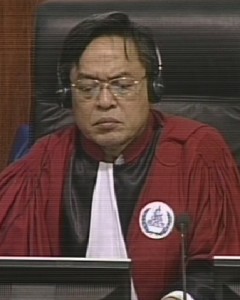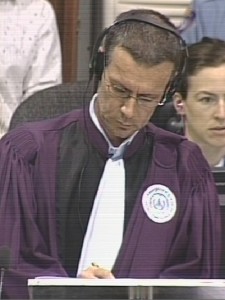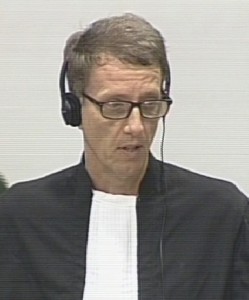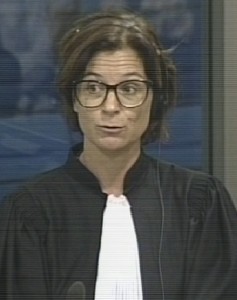First Witness on the Treatment of the Vietnamese

Trial Chamber President Nil Nonn
During today’s hearing in front of the ECCC, the testimony of 2-TCW-996 came to an end and the testimony of 2-TCW-868 commenced. All three sessions related to the first witness were held in camera and were not accessible to the public and media. The author of this report will provide a summary of the redacted transcript once these are made available. Witness 2-TCW-868 – Sean Sung – testified about a massacre of Vietnamese people that he said he had witnessed.
In the fourth session, Trial Chamber President Nil Nonn announced that the testimony of witness 2-TCW-868 would be heard in public as far as possible. Witness Sean Sung, 55 years old, was born in Toul Sar Village, Kampong Khleang Commune, Soutr Nikum District, Siem Reap Province. Currently he is living in the same village. The President then gave the floor to the Office of the Co-Prosecutors.
Senior Assistant Prosecutor Vincent de Wilde started his line of questioning by inquiring where Mr. Sung was living and working between 1975 and 1979. Mr. Sung replied that he worked in a mobile unit to harvest rice. Both New People and Base People lived there. There was a Vietnamese family amongst the New People. The name of an unmarried Vietnamese woman was Chantha in that village.
Mr. de Wilde inquired whether Mr. Sung had heard that lists of Vietnamese people had been drawn in Chea Kreng, which Mr. Sung denied.
Next, Mr. de Wilde inquired whether there was a massacre in Khsach Pagoda in 1978 and what happened there. At this point, Nuon Chea Defense Counsel Victor Koppe interjected and asked “what kind of question is this” to ask whether there was a massacre in 1978. Mr. de Wilde rephrased his question and asked what major event took place at the pagoda in 1978. Mr. Sung replied that he saw “Vietnamese people being killed and dropped into a pit.”
At the time, there were no Buddhist monks and ceremonies there. Mr. Sung did not know the reason for it. The pagoda was used to host mobile unit workers temporarily for a fortnight. The witness himself lived outside the parameters of the pagoda. Part of the surrounding had a fence, but it was not entirely surrounded by a fence. The fence was made of wood and “it was not that strong.” The event took place in the rainy season, but Mr. Sung could not recall how much time before the Vietnamese arrived this took place.
Mr. de Wilde then referred to the witness’s Written Record of Interview, in which he had stated that the massacre took place in November 1978.[1] In another Written Record of Interview, he had said that the event took place during harvest season, probably in September or October of that year.[2] Mr. de Wilde asked whether it took place during the rainy season, as Mr. Sung had said earlier, or during the harvest season. Mr. Sung replied that it was during the harvest season when he “had to wade through the water of the rice fields”.

Senior Assistant Prosecutor Vincent de Wilde
Mr. de Wilde inquired whether Mr. Sung witnessed one or several arrests, which Mr. Sung denied. “What I saw is that they had already been there in the pagoda.” In his mobile unit, a female worker was removed. Her name, as mentioned earlier, was Chantha. She told the other workers that she was being transferred to Phnom Penh to study. Chantha was Vietnamese, according to the witness, as were her grandparents. She was born in Cambodia. When asked about her accent, Mr. Sung said that “she spoke Khmer clearly.” In his view, people could recognize by looking at Chantha that she was Vietnamese.
When Mr. de Wilde inquired how the people were taken to the pagoda, Mr. Koppe stood up and objected. He stated that “there is complete chaos” in the way the questions were asked, since Mr. de Wilde had not asked how the witness knew that the people were arrested and it was not clear who “they” were. According to Mr. Koppe, the questioning jumped from one topic to another.
Mr. de Wilde asked how Mr. Sung knew about the transportation, since he had not been there himself. Mr. Sung replied that he heard that the people were transported by oxcarts. “They said that they were Vietnamese”, he recounted. When taken to the pagoda, they were killed the same night. However, he could not observe anything happening at the pagoda from the distance.
He witnesses the massacre when he was walking back from his mobile unit. He was on a road next to the pagoda around 200 meters away. “I heard the voices from the pagoda”, so he “had a secret look” to see what was taking place inside the pagoda. He saw people being walked out of the library hall, which was located in the middle of the premise of the pagoda.
Mr. de Wilde then referred to the witness’s interview, in which he had stated that “as of 7 o’clock I heard a lot of people crying in the pagoda”, after which he went to the village to gather information. When the villagers could not give him any insight, he went to the pagoda.[3] Mr. de Wilde asked whether it was true that he heard people crying at the pagoda, which Mr. Sung confirmed. “I knew it was risky, but I actually hit myself in a pit and I just approached the pagoda cautiously. And I had actually had a look while I was about 30 meters away from the pagoda.” When he arrived at the pagoda, the execution was being carried out.
Mr. de Wilde asked how much time passed between the moment that he heard the people cry in the pagoda at 7 pm and the one when he witnessed the execution. Mr. Sung replied that he stood there “watch the event unfold” for around an hour before leaving. A friend came with him and left together with him. When looking at the entrance, the execution took place on the right-hand side. The massacre took place around five or six meters behind the fence outside the premise of the pagoda. There were around ten to twelve people who were executing the victims. The victims did not attempt to flee.
The kerosene lanterns were lit, so he could clearly see what was happening. He could clearly see the killings. He could also hear what was happening, so he heard the conversations between the guards and the soldiers. The soldiers were talking to the victims. “The victims were interviewed whether they were Chinese or Vietnamese.” Those who said that they were Vietnamese were killed at the pit. He confirmed that he saw children being executed. Asked about his reaction when he realized that also children were killed, Mr. Sung said that he was scared.
Mr. de Wilde asked why Mr. Sung stayed so long to watch the executions and did not flee. Mr. Sung replied that “there was one adult” who watched with him. Since this person was older than him, he dared to look at the incidence together with that person. He confirmed that some people said that they were Chinese and not Vietnamese. The soldiers walked those who said that they were Chinese “into the place.” They were walked into the compound once they said that they were Chinese. He noticed that “killings happened after which some people were put onto the oxcart and taken away.”
At this point, Mr. Koppe said that he noticed that a person was sitting in the audience who might have given interviews before. Mr. Koppe asked to verify whether this was indeed his wife. He argued that the spouse of the witness had been interviewed before and, despite not being on a witness list at the moment, might be summoned to testify in the future.[4]
The President instructed the court officer to ask the woman who was sitting in the public gallery how she is related to the witness and asked Mr. Sung how he was related to that person. Mr. Sung confirmed that this is his wife.

International Defense Counsel Victor Koppe
Mr. Koppe stated that this person was not on the list at the moment, but one of the parties might request to summon her at a later stage to ask for corroborative evidence. He requested to continue the hearing tomorrow without her presence.
Judge Claudia Fenz inquired whether she understood correctly that Mr. Koppe requested to exclude the wife from attending the public gallery, while she had not been put on any witness list of any party yet. Mr. Koppe confirmed this.
Judge Lavergne asked whether Mr. Koppe was “seriously saying” that they could prevent someone from attending the hearings based on the mere fact that one of the parties may call that person. “This is a public trial.” Mr. Koppe replied that this situation was different from other situations where the spouse of a witness attended the hearing, since the witness’s wife had been interviewed, and the record of her interview had recently been given an E3 number.
Judge Fenz asked whether he hence demanded to prevent her from coming from tomorrow morning onwards. If this was the case, they could rule on it in the morning. Mr. Koppe denied this and said his request also referred to today’s session.
Mr. de Wilde took the floor and said that he had read the respective interview. This interview did not concern the massacre at the Ksach Pagoda, and Mr. Koppe’s request was therefore unjustified.
Civil Party Lead Co-Lawyer Marie Guiraud said that she agreed with Mr. de Wilde. If the person was not on any list, it was “very difficult to refuse someone who was not proposed” to enter the courtroom.
After conferring with the bench, the President announced that there was no sufficient ground to prevent the witness’s wife from being in the public gallery and observe the court proceeding. The Chamber would not order to remove her from the audience neither today nor tomorrow.

Civil Party Lead Co-Lawyer Marie Guiraud
Mr. de Wilde took up his line of questioning again. He referred to Mr. Sung’s interview, in which he had said that the people who were identified as Chinese during the massacre were released after having looked for their relatives.[5] In today’s testimony, Mr. Sung had said that these persons were taken to another location. Mr. de Wilde asked to clarify this matter. Mr. Sung replied that the people were walked out of the killing site to look for their relatives and sent back to their villages subsequently.
Mr. de Wilde inquired how the witness knew that the executioners were soldiers and whether he knew their units. Mr. Sung replied that he had said so, since “each of them was armed with a weapon”, but did not know which unit they belonged to. He had never seen the soldiers before. People were addressed by using the word “comrade”, so he did not know any names. The soldiers drank alcohol while carrying out the executions. The victims were not blindfolded. The victims were “acting normal” when they saw the other dead bodies, Mr. Sung recounted. He did not know whether they were terrified or not. He did not hear any cries or screaming from the pit.
Some victims were undressed, while others were dressed. Others were undressed for half of their bodies. “They used the bamboo sticks of around 70 centimeters in length” to kill the people. Some children “were killed” while others were thrown into the pits. Asked to clarify this, Mr. Sung recounted that some children were thrown into the air and fainted when they fell onto the ground.
At this point, the President announced that the testimony would continue tomorrow morning at 9am.
[1] E3/9335, at p. 2 in all languages. [2] E3/7890, at p. 2 in all languages. [3]E3/9335, at p. 2 in French, pp. 2-3 in English, p. 2 in Khmer. [4] The respective Written Record of Interview is E3/9390. [5] E3/9335, p. 4 in all languages.

[…] at Khsach Pagoda that he says he witnessed. This massacre had been described by witness Sean Sung earlier this year. Sun and Sung both told the Court that they witnessed the killing of Vietnamese people together . […]